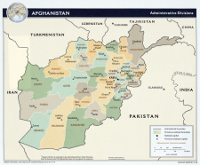Coalition and Afghan special operations teams killed a senior, dual-hatted Taliban and Islamic Movement of Uzbekistan commander during a raid in a district in the Afghan north that has been identified as a terrorist “safe haven.”
The International Security Assistance Force confirmed that the commander, Mullah Abdul Fatah Haqqani, was killed in an airstrike in the district of Burkah in Baghlan province yesterday.
“Haqqani supported both the Taliban and Islamic Movement of Uzbekistan networks by commanding and controlling foreign fighter facilitation and insurgent training for Baghlan province,” ISAF stated in a press release. ISAF uses the term “foreign fighters” to describe members of al Qaeda and allied groups.
Haqqani also “was responsible for overseeing the purchase of weapons and explosive devices for Taliban insurgents, supporting numerous attacks against Afghan and coalition forces throughout the area.”
ISAF previously identified the Burkah district as a “Taliban and Islamic Movement of Uzbekistan safe haven,” in a press release announcing the March 14 nighttime raid that targeted Taliban and IMU fighters.
Burkah has been the target of 11 special operations raids since the beginning of March. Nine of those raids took place in March. During one raid, on March 19, ISAF targeted four “key” Islamic Movement of Uzbekistan commanders, “including the most senior IMU leader and Taliban liaison.”
Also, during a March 8 raid in Burkah, ISAF targeted a Taliban commander who is linked to the Islamic Movement of Uzbekistan and leads “approximately 80 foreign fighters of Uzbek, Chechen and Tajik descent.”
Haqqani is the second IMU commander who has been killed or captured during raids in Baghlan since April 17. On that date, ISAF and Afghan forces captured a facilitator who “operates concurrently for the Taliban and the Islamic Movement of Uzbekistan,” during a raid in the Baghlan-e Jadid district. The Taliban/IMU facilitator “provides both group’s leaders situational updates on attacks targeting coalition forces and facilitates bed-down locations for insurgents.”
Background on terrorist havens in the north
ISAF has begun to identify the location of safe havens and training camps in the north for the Taliban and the allied Islamic Movement of Uzbekistan. Both terror groups maintain a strong presence in the northern Afghan provinces of Badakhshan, Baghlan, Balkh, Faryab, Jawzjan, Kunduz, Samangan, Sar-i-Pul, and Takhar, and have established suicide training camps in the north over the past several years. As the two groups expand their presence in the north, top leaders of the Islamic Movement of Uzbekistan have integrated into the Taliban’s shadow government in the northern provinces.
ISAF has identified the presence of camps in Sar-i-Pul and Samangan provinces. On March 22, the special operations team captured an IMU commander who ran camps in Samangan.
The IMU has eastablished camps in Kunduz province, a Taliban commander from Baghlan named Mustafa recently told the Asia Times. The Taliban commander said that jihadis from Central Asia, including “Chechnya, Uzbekistan, Tajikistan, and Russia,” make up a significant portion of the fighters in the the Afghan north and that they are setting their sights on the neighboring country of Uzbekistan.
“I can tell you that there is an active connection between the Central Asian command and the Taliban in northern Afghanistan and they often join us, but how they connect, this is beyond my level,” Mustafa told Asia Times. “Our superior commanders are in touch with their counterparts in Central Asia and if somebody arrives in Afghanistan or goes to Central Asia from Afghanistan, it is arranged at a senior leadership level.”
In late January 2011, Afghan police in Kunduz said they were looking for 15 Chechen women in the northern Afghan province who are aiding the Taliban. The women are either serving as nurses or “are experts in making roadside bombs and suicide vests.”
IMU integrating operations with the Haqqani Network
The IMU has also shown signs of integrating its operations with the Haqqani Network in the Afghan east and southeast. On April 12, ISAF targeted a facilitator who works for both the Haqqani Network and the Islamic Movement of Uzbekistan and aids “foreign fighters, including Iranians” to carry out attacks in the east. The raid took place in the Orgun district in Paktika province.
And on April 16, combined Afghan and Coalition special operations forces captured two Haqqani Network commanders during a raid in Ghazni City, the provincial capital of Ghazni. According to the International Security Assistance Force press release, one of the facilitators “worked for both Haqqani and Islamic Movement of Uzbekistan leaders” in the Orgun district in Paktika province, and he aided “Uzbek foreign fighters to support Haqqani attacks in Afghanistan and Pakistan.” The other Haqqani Network facilitator “provided safe havens for foreign fighters traveling from Kunduz to Paktika province and Pakistan for tactical training and operations.”









3 Comments
Bill: where did this Haqqani reside in the family tree?
Jim
Jim,
That is a good question which I have not been able to answer at this time. Haqqani is a common name in the region. The Haqqanis are known to operate in neighboring Kunduz as well.
It’s hard to complain about this kind of news, but between Haqqani, the commander killed April 17th, and Zawahiri’s brother-in-law; a substantial amount of intel could have been developed if they had been captured instead of killed. Just the same; great job ISAF!